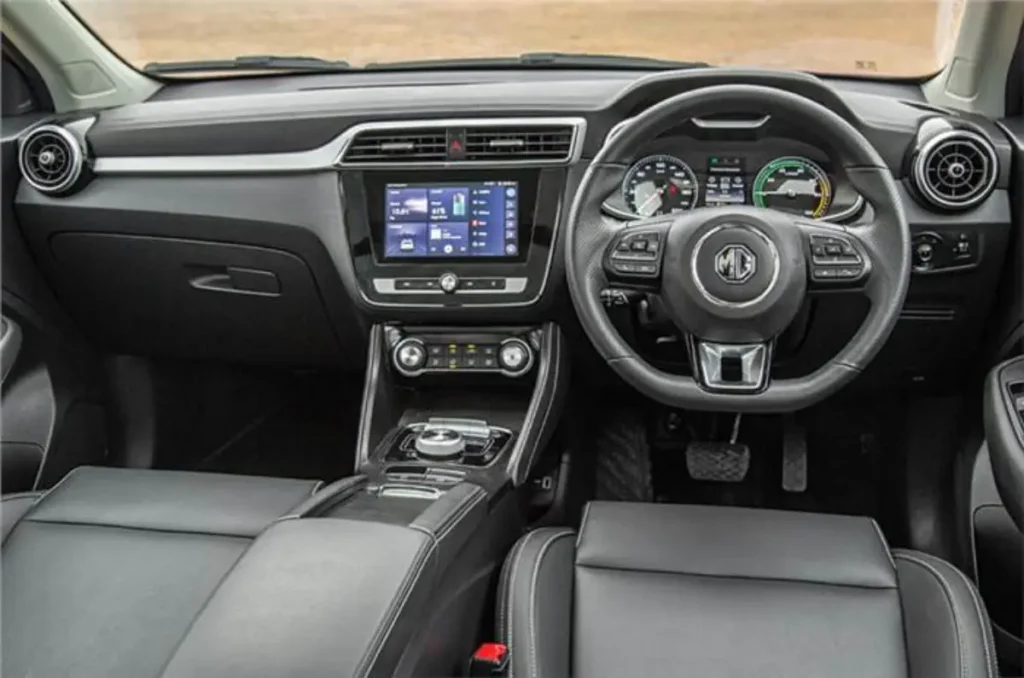MG ZS EV: In India, MG got off to a lightning start, with the Hector becoming an overnight sensation. But as the conversation quickly turned to electric transportation, MG moved quickly to launch the MG ZS EV SUV. A few months ago, we had the opportunity to test drive the prototype and were quite impressed. However, how much has changed since then, and is everything we loved still present in the production model?

With the exception of the MG ZS EV badge, there are no external similarities between it and the Hector. The production-spec SUV resembles the prototype exactly, save for the ‘Internet Inside’ badging on the back.
Not much has changed inside. Leather is used a lot in the cabin, and the materials are very well made. The KERS and drive mode buttons feel premium, and the 8.0-inch touchscreen is responsive. Everything is positioned as one might expect in terms of ergonomics, with the exception of the USB ports, which are concealed beneath the centre console. There is ample space in the back, and the seats are much more comfortable than those of its Indian competitor, the Hyundai Kona.

The list of equipment is just as long as the Kona’s. While some features—like the telescopic steering adjuster—are absent, the iSMART voice-command system with an embedded SIM and a panoramic sunroof are included (like on the Hector). A PM 2.5 filter is a well-considered addition.
Because of features like stability control, ABS with EBD, brake assist, six airbags, and more, the e-SUV also earned a five-star Euro NCAP safety rating. Geo-fencing, charging station locations, and speed limit infraction alerts can all be configured with the aid of the i-Smart app.
When everything is taken into account, the MG ZS EV core is what makes it unique. Flexing your right foot releases the entire 142.7hp and 353Nm of torque produced by the permanent magnet synchronous motor. But in the case of electric SUVs, range comes first and performance is secondary. The ZS boasts a robust 44.5kWh lithium-ion battery pack that is IP67 certified, enabling it to travel over 340 kilometres on a single charge. Even though this figure was obtained under ideal testing circumstances, a fully charged battery should provide a real-world range of about 260–290 km.
And speaking of which, the battery-charging time is another important factor. The ZS comes with a 7.4kW AC charger as standard, which MG ZS EV will install at your house or place of business at no additional cost. The 50kW DC fast charger is another option; it can juice up devices from 0-80% in just 50 minutes. A few MG dealerships have installed these fast chargers, which are available whenever needed. Additionally, a standard three-pin charger can be used to charge the MG ZS EV through a 15A socket. It will take a while (usually 16–18 hours), but this is more of a safety precaution in case you get stuck without fast charging. Finally, MG has designated specific routes for mobile charging vans that can be called upon for an instant top-up.
It is obvious that MG ZS EV Motor has made every effort to reduce range anxiety, which most users would experience. The Kinetic Energy Recovery System (KERS), which essentially charges the battery during braking and deceleration, is also included. Unlike the Kona, the KERS level can be manually adjusted with paddles, but it is modulated via a toggle switch. It takes a while to fully charge the battery because, in contrast to the Hyundai, the MG ZS EV decelerates linearly when using its maximum KERS setting. The performance of the battery is also greatly affected by the drive mode you choose. Sport naturally uses up a lot of charge because it offers the best response and performance. While the EV is in its most conservative setting in ECO mode, where responses are dulled for that extra range gain, comfort mode strikes a delicate balance.
Although there is little feedback from the steering when driving, body roll is well-contained, and cornering grip is respectable. With the exception of jagged bumps, the suspension effectively absorbs most rough spots, and the ride quality is good.
The ZS is difficult to criticise overall. It is practical, has a long list of features, is roomy inside, has a respectable boot, and its 340 km stated range is more than sufficient for some intra-city commuting. In order to compete with the slightly pricey Hyundai Kona Electric and the soon-to-be-much cheaper Tata Nexon EV, MG Motor India will need to find the happy medium between the two when it comes to its new EV. The ZS EV, in contrast to the Kona, will come in two models: Exclusive and Excite, with the latter being the highest-spec model. The panoramic sunroof and iSMART connectivity are among the features that The Excite will not have, but it will likely be priced much more aggressively to compete with the Tata Nexon. The ZS is further strengthened by a five-year/unlimited-kilometer warranty, a five-year labor-free guarantee, and a five-year free roadside assistance programme.
MG ZS EV Review On You-Tube
Also Read: Yamaha MT-15: The Perfect Blend of Agility and Power

